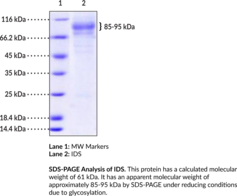Territorial Availability: Available through Bertin Technologies only in France
- Correlated keywords
- SD 1 2 MPSII Ser 26 SDSPAGE MPS2 MPS 2 SIDS
- Product Overview:
Iduronate 2-sulfatase (IDS) is a lysosomal exohydrolase belonging to the sulfatase family and is required for the degradation of the glycosaminoglycans heparan sulfate and dermatan sulfate.{56118,56119} IDS is synthesized as a 550-amino acid precursor comprised of an N-terminal signal peptide and propeptide that are cleaved during secretion and maturation, followed by two subdomains, SD1, which contains the catalytic core, and the catalytically-inactive SD2.{56119,56120,56121} SD1 and SD2 can be separated by proteolytic cleavage and remain stably associated in an enzymatically active form. IDS is highly expressed in the brain, particularly in the cortex, amygdala, hippocampus, hypothalamus, and basal ganglia, with lower levels observed in the cerebellum and spinal cord.{56120} Mutations in IDS resulting in IDS functional deficiencies cause Hunter syndrome, also known as mucopolysaccharidosis type II (MPS II), an X-linked lysosomal storage disease.{56118,56119} Formulations containing recombinant human IDS have been used in the treatment of Hunter syndrome. Cayman’s IDS (human, recombinant) protein can be used for enzyme activity assay applications. This protein consists of 536 amino acids, has a calculated molecular weight of 61 kDa, and a predicted N-terminus of Ser26 after signal peptide cleavage. By SDS-PAGE, under reducing conditions, the protein migrates as several bands with apparent molecular masses of 85 to 95 kDa due to glycosylation.
Cayman Chemical’s mission is to help make research possible by supplying scientists worldwide with the basic research tools necessary for advancing human and animal health. Our utmost commitment to healthcare researchers is to offer the highest quality products with an affordable pricing policy.
Our scientists are experts in the synthesis, purification, and characterization of biochemicals ranging from small drug-like heterocycles to complex biolipids, fatty acids, and many others. We are also highly skilled in all aspects of assay and antibody development, protein expression, crystallization, and structure determination.
Over the past thirty years, Cayman developed a deep knowledge base in lipid biochemistry, including research involving the arachidonic acid cascade, inositol phosphates, and cannabinoids. This knowledge enabled the production of reagents of exceptional quality for cancer, oxidative injury, epigenetics, neuroscience, inflammation, metabolism, and many additional lines of research.
Our organic and analytical chemists specialize in the rapid development of manufacturing processes and analytical methods to carry out clinical and commercial GMP-API production. Pre-clinical drug discovery efforts are currently underway in the areas of bone restoration and repair, muscular dystrophy, oncology, and inflammation. A separate group of Ph.D.-level scientists are dedicated to offering Hit-to-Lead Discovery and Profiling Services for epigenetic targets. Our knowledgeable chemists can be contracted to perform complete sample analysis for analytes measured by the majority of our assays. We also offer a wide range of analytical services using LC-MS/MS, HPLC, GC, and many other techniques.
Accreditations
ISO/IEC 17025:2005
ISO Guide 34:2009
Cayman is a leader in the field of emerging drugs of abuse, providing high-purity Schedule I-V Controlled Substances to federally-licensed laboratories and qualified academic research institutions for forensic analyses. We are certified by ACLASS Accreditation Services with dual accreditation to ISO/IEC 17025:2005 and ISO Guide 34:2009.





